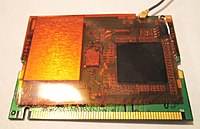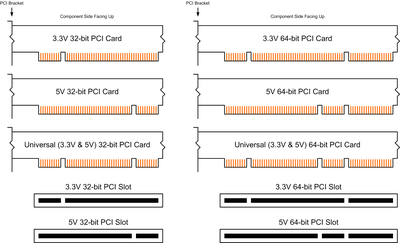|
|
Low-profile (half-height) card
The PCI organization has defined a standard for "low-profile" cards, which basically fit in the following ranges:
- Height: 1.42 inches (36.07 mm) to 2.536 inches (64.41 mm)
- Depth: 4.721 inches (119.91 mm) to 6.6 inches (167.64 mm)
The bracket is also reduced in height, to a standard 3.118 inches (79.2 mm). The smaller bracket will not fit a standard PC case. Many manufacturers supply both types of bracket (brackets are typically screwed to the card so changing them is not difficult).
These cards may be known by other names such as "slim".
Mini PCI
[size=94%]  [size=94%] 
Mini PCI Wi-Fi card Type IIIB
Mini PCI was added to PCI version 2.2 for use in laptops, it uses a 32-bit, 33-MHz bus with powered connections (3.3 V only) and support for bus mastering and DMA. The standard size for Mini PCI cards is approximately 1/4 of their full-sized counterparts. As there is no external access to the card in the same manner that there is for desktop PCI cards, Mini PCI cards are generally limited in the functions they may perform.
[size=94%]  [size=94%] 
MiniPCI-to-PCI converter Type III
Many Mini PCI devices were developed such as Wi-Fi, Fast Ethernet, Bluetooth, modems (often Winmodems), sound cards, cryptographic accelerators, SCSI, IDE/ATA, SATAcontrollers and combination cards. Regular PCI cards can be used with Mini PCI-equipped hardware and vice-versa, using Mini PCI-to-PCI and PCI-to-Mini PCI converters. Mini PCI has been superseded by PCI Express Mini Card.
Technical details of Mini PCI
Mini PCI cards have a 2 W maximum power consumption, which also limits the functionality that can be implemented in this form factor. They also are required to support the CLKRUN# PCI signal used to start and stop the PCI clock for power management purposes.
There are three card form factors: Type I, Type II, and Type III cards. The card connector used for each type include: Type I and II use a 100-pin stacking connector, while Type III uses a 124-pin edge connector, i.e. the connector for Types I and II differs from that for Type III, where the connector is on the edge of a card, like with a SO-DIMM. The additional 24 pins provide the extra signals required to route I/O back through the system connector (audio, AC-Link, LAN, phone-line interface). Type II cards have RJ11 and RJ45 mounted connectors. These cards must be located at the edge of the computer or docking station so that the RJ11 and RJ45 ports can be mounted for external access.
TypeConnectorSize IA 100-Pin Stacking 7.5 × 70 × 45 mm IB 100-Pin Stacking 5.5 × 70 × 45 mm IIA 100-Pin Stacking 7.5 × 70 × 45 mm IIB 100-Pin Stacking 17.44 × 78 × 45 mm IIIA 124-Pin Card Edge 2.4 × 59.6 × 50.95 mm IIIB 124-Pin Card Edge 2.4 × 59.6 × 44.6 mm
Other physical variations
Typically consumers systems specify "N x PCI slots" without specifying actual dimensions of the space available. In some small form-factor systems, this may not be sufficient to allow even "half-length" PCI cards to fit. Despite this limitation, these systems are still useful because many modern PCI cards are considerably smaller than half-length.
Card keying
[size=94%][url=http://en.wikipedia.org/wiki/File  CI_Keying.png]  [/url] [size=94%][url=http://en.wikipedia.org/wiki/File  CI_Keying.png]  [/url]
Diagram showing the different key positions for 32-bit and 64-bit PCI cards
Typical PCI cards present either one or two key notches, depending on their signaling voltage. Cards requiring 3.3 volts have a notch 56.21mm from the front of the card (where the external connectors are) while those requiring 5 volts have a notch 104.47mm from the front of the card. So called "Universal cards" have both key notches and can accept both types of signal.
See also
References
[size=90%]
External links
|
|
 /3
/3 
 /3
/3 